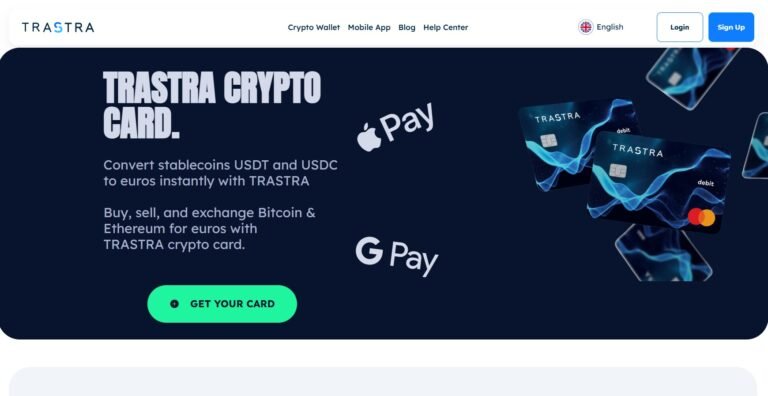Table of Contents
Introduction to Trastra
This is a detailed Trastra review aimed at helping users who feel scammed or suspicious about the platform. Trastra is known as a cryptocurrency payment and debit card provider, claiming to allow users to manage both crypto and fiat via a simple wallet and card system. The company is reportedly registered in the Czech Republic but operates globally—particularly in Europe.
However, growing user complaints and vague regulatory affiliations have triggered legitimate concerns: is Trastra a scam or a trustworthy service? This Trastra review uncovers all the warning signs you need to know.
Whether you’ve already lost money with Trastra or are still considering using their services, this article speaks directly to your anger and confusion. If you’re suspicious or already harmed, you deserve the real truth behind this crypto project.
Trastra: Regulation & Legal Status
Trastra claims to operate under EU law and reportedly partners with licensed financial institutions. However, there’s no clear documentation showing that Trastra itself holds a license from any major regulator like the SEC, FCA, or BaFin. Its terms vaguely refer to third-party financial providers for services, which complicates user protection and dispute resolution.
Relying on “affiliated partners” instead of having a direct license is a tactic used by many shady crypto projects. This means if something goes wrong, users have limited legal recourse and no access to investor compensation schemes.
Transparency is critical when dealing with financial platforms, and in this case, it’s lacking. Check Trastra’s safety profile here to assess its trustworthiness. The absence of a direct regulatory body raises serious concerns about whether Trastra is a scam.
Trading Conditions & Platform Analysis of Trastra
Unlike traditional crypto exchanges, Trastra functions more as a crypto wallet and card issuer. There are no formal “account types” or leverage offerings like in a trading platform, but users can purchase and convert between crypto and fiat directly through the app.
That said, Trastra fails to provide complete transparency around fees, crypto liquidity sources, and transaction timelines. Many users have reported slow top-ups, unclear limits, and a lack of real-time support—factors that damage its credibility.
The app design itself is polished, which can trick users into trusting it too quickly. But remember: design doesn’t equal trust. Before engaging, here’s what to check before signing up with a trading platform or crypto wallet.
These inconsistencies make it hard to ignore the risk that Trastra might be a fraud hiding behind sleek branding.
Reputation & User Reviews About Trastra
Trastra reviews across the web present a mixed reputation. On Trustpilot, it holds an average rating, but recent reviews report a surge in complaints about frozen cards, poor support, and unexplained delays in withdrawals and account verifications.
Many positive testimonials appear generic and possibly fabricated—short phrases like “great service” or “love the card” without context. These kinds of reviews often suggest a deliberate attempt to bury legitimate user concerns.
Third-party analysis on ScamDoc gives Trastra a relatively low trust score, citing issues like domain anonymity and unverified ownership.
Overall, this signals that users should be wary. The reputation does little to erase the concern: is Trastra a scam operating under the guise of a fintech service?
How to Test Whether Trastra Is a Scam
Before committing funds to Trastra, take these concrete steps to evaluate its legitimacy:
- Check for regulation: Look for direct licenses under major regulatory bodies. Partnerships aren’t the same as regulatory protection.
- Look for red flags: Does the company avoid naming its legal entities or hide terms behind vague language? That’s a warning sign.
- Read user reviews: Focus on detailed, timestamped complaints—not short, generic testimonials.
- Test customer service: Reach out with real questions. If you get copy-paste replies or no reply at all, be cautious.
- Examine withdrawal terms: Do they charge hidden fees or restrict crypto-to-fiat transfers without explanation?
- Beware of false promises: If the platform claims zero risk or guaranteed returns, walk away immediately.
- Try small transactions first: If you must use it, start with minimal funds to avoid large losses.
Still unsure? Use the FTC’s fraud reporting tool to report suspicious behavior or learn if others have filed complaints.
Final Verdict & Alternatives
Based on this review, Trastra exhibits multiple red flags, including regulatory ambiguity, poor customer service, and growing user complaints. While the service may have worked for some, its overall lack of transparency and protections makes it too risky for serious users.
If you’re seeking safer alternatives, consider licensed services like:
- Wirex – FCA regulated
- Revolut – holds e-money licenses across the EU and UK
- Coinbase Card – offered by a fully regulated crypto exchange
Bottom line: If you’re asking, is Trastra a fraud? — there’s enough evidence here to warrant extreme caution or complete avoidance.



